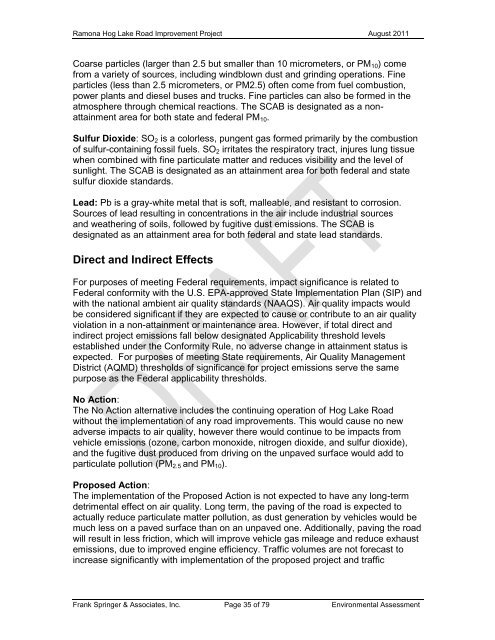environmental assessment for the hog lake road improvement project
environmental assessment for the hog lake road improvement project
environmental assessment for the hog lake road improvement project
You also want an ePaper? Increase the reach of your titles
YUMPU automatically turns print PDFs into web optimized ePapers that Google loves.
Ramona Hog Lake Road Improvement Project August 2011<br />
Coarse particles (larger than 2.5 but smaller than 10 micrometers, or PM10) come<br />
from a variety of sources, including windblown dust and grinding operations. Fine<br />
particles (less than 2.5 micrometers, or PM2.5) often come from fuel combustion,<br />
power plants and diesel buses and trucks. Fine particles can also be <strong>for</strong>med in <strong>the</strong><br />
atmosphere through chemical reactions. The SCAB is designated as a nonattainment<br />
area <strong>for</strong> both state and federal PM10.<br />
Sulfur Dioxide: SO2 is a colorless, pungent gas <strong>for</strong>med primarily by <strong>the</strong> combustion<br />
of sulfur-containing fossil fuels. SO2 irritates <strong>the</strong> respiratory tract, injures lung tissue<br />
when combined with fine particulate matter and reduces visibility and <strong>the</strong> level of<br />
sunlight. The SCAB is designated as an attainment area <strong>for</strong> both federal and state<br />
sulfur dioxide standards.<br />
Lead: Pb is a gray-white metal that is soft, malleable, and resistant to corrosion.<br />
Sources of lead resulting in concentrations in <strong>the</strong> air include industrial sources<br />
and wea<strong>the</strong>ring of soils, followed by fugitive dust emissions. The SCAB is<br />
designated as an attainment area <strong>for</strong> both federal and state lead standards.<br />
Direct and Indirect Effects<br />
For purposes of meeting Federal requirements, impact significance is related to<br />
Federal con<strong>for</strong>mity with <strong>the</strong> U.S. EPA-approved State Implementation Plan (SIP) and<br />
with <strong>the</strong> national ambient air quality standards (NAAQS). Air quality impacts would<br />
be considered significant if <strong>the</strong>y are expected to cause or contribute to an air quality<br />
violation in a non-attainment or maintenance area. However, if total direct and<br />
indirect <strong>project</strong> emissions fall below designated Applicability threshold levels<br />
established under <strong>the</strong> Con<strong>for</strong>mity Rule, no adverse change in attainment status is<br />
expected. For purposes of meeting State requirements, Air Quality Management<br />
District (AQMD) thresholds of significance <strong>for</strong> <strong>project</strong> emissions serve <strong>the</strong> same<br />
purpose as <strong>the</strong> Federal applicability thresholds.<br />
No Action:<br />
The No Action alternative includes <strong>the</strong> continuing operation of Hog Lake Road<br />
without <strong>the</strong> implementation of any <strong>road</strong> <strong>improvement</strong>s. This would cause no new<br />
adverse impacts to air quality, however <strong>the</strong>re would continue to be impacts from<br />
vehicle emissions (ozone, carbon monoxide, nitrogen dioxide, and sulfur dioxide),<br />
and <strong>the</strong> fugitive dust produced from driving on <strong>the</strong> unpaved surface would add to<br />
particulate pollution (PM2.5 and PM10).<br />
Proposed Action:<br />
The implementation of <strong>the</strong> Proposed Action is not expected to have any long-term<br />
detrimental effect on air quality. Long term, <strong>the</strong> paving of <strong>the</strong> <strong>road</strong> is expected to<br />
actually reduce particulate matter pollution, as dust generation by vehicles would be<br />
much less on a paved surface than on an unpaved one. Additionally, paving <strong>the</strong> <strong>road</strong><br />
will result in less friction, which will improve vehicle gas mileage and reduce exhaust<br />
emissions, due to improved engine efficiency. Traffic volumes are not <strong>for</strong>ecast to<br />
increase significantly with implementation of <strong>the</strong> proposed <strong>project</strong> and traffic<br />
Frank Springer & Associates, Inc. Page 35 of 79 Environmental Assessment
















